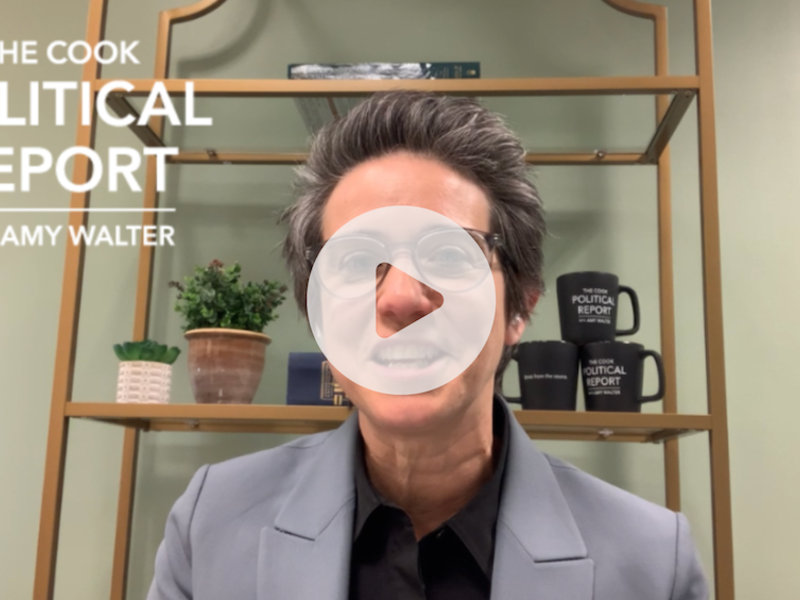
With just over a week to go before the midterm election, it is good to keep in mind the memorable line some attribute to Texas Tech Sports Information Director Ralph Morgan, when Texas A&M tied Tech 72-72 late in the 1976 Southwest Conference basketball championship game: “The opera ain’t over ‘til the fat lady sings.” While it sure looks like a Republican takeover of the House is a fait accompli, and Democratic nervousness about their tenuous hold on a 50-50 Senate is very understandable, surprises in recent elections remind us of the vagaries inherent in trying to anticipate election outcomes.
In the days leading into the 2016 presidential election Donald Trump’s defeat seemed all but assured. Yet he prevailed over Hillary Clinton by a combined 77,736 total votes in Michigan, Pennsylvania, and Wisconsin, even while losing the national popular vote by just over 2 percentage points. Four years later Trump’s unimpressive performance in the Sept. 29 debate seemed to auger an easy Joe Biden win. While the former vice president did prevail by 4.5 percentage points and (just over 7 million votes nationally), in the much more relevant vote count in key states, Biden’s margin ended up just 125,088 total votes in Arizona (10,457), Georgia (11,779), Pennsylvania (82,166), and Wisconsin (20,682).
In that same November election, it certainly appeared that Democrats would recapture the Senate with a net gain of at least three or four Senate seats, only to score a net gain of a single seat in the November general election. They needed Raphael Warnock’s 93,272-vote victory over appointed GOP Sen. Kelly Loeffler and Jon Ossoff’s 54,944-vote win over elected Sen. David Perdue in the Georgia runoffs on Jan. 5 (to say nothing of incoming Vice President Kamala Harris’s tie breaking vote) to give them majority status.
The anticipated expansion of Democrats' House margin in that November 2020 election ended up being a contraction of a dozen seats. The party ended up retaining their majority by just 31,751 total votes spread across five districts. Suffice to say that, at least in politics, things are often not nearly as sure as they seem to be.
My colleague Amy Walter took a look at how House and Senate races rated as “Toss Ups” going into Election Day ended up going in past cycles—something worth keeping in mind over the next week. Interestingly, in the last four elections, 2014 through 2020, Democrats finished rather poorly, with Republicans winning 23 (72 percent) of 32 Toss Up Senate contests and 62 (65 percent) of the 96 Toss Up House races. In the four previous elections, 2006 through 2012, Democrats did considerably better, capturing 29 (81 percent) of the 36 Toss Up Senate races and 76 (51 percent) out of the 150 House contests.
In six of the last eight elections, four held in presidential years, two in midterms, the House and Senate Toss Ups broke in the same direction. One exception came in 2010, President Obama’s first midterm election, when 33 of the 50 Toss Up House contests broke in favor of Republicans, while five of the seven Toss Up Senate races went Democratic.
The other was 2018, President Trump’s midterm election, in which 21 of the 30 House races rated Toss Up broke in favor of Democrats, propelling the party to a 42 seat net gain and control of that chamber. The GOP took five of the nine Senate Toss Ups, albeit just marginally.
It has long been my view that the final races rated as Toss Ups rarely split down the middle, they break in the direction of the last gust of wind occurring in the days before Election Day (or in more recent years with so many ballots cast early, election weeks) but that does not explain the streaky nature of this races, why the last four elections would behave differently from the previous four elections.
Given how Toss Ups have broken in the last four elections, coupled with polling continually understating Republican support, it is little wonder why Democrats are so anxious right now. For much of the last two years, this election was behaving as we have come to expect midterm elections, as a straight-up referendum on the incumbent president and governing party. In August and September however, after the Supreme Court reversed the landmark Roe v. Wade abortion decision, and after gas prices dropped from over $5 a gallon to under $4, it seemed to be more of a choice election. But over the last three weeks, it seems to have returned to the more conventional referendum dynamic.
How this election finishes is thus an open question. When does the curtain fall on this opera? The House, where individual races and candidates matter less and the behavior is more parliamentary, the outcome is very likely to be quite bad for Democrats. My personal hunch is Democrats suffer net losses of at least 20 seats, but in the Senate, the difference between either party picking up or losing a seat or two could easily be minimal. In the upper chamber, the party that wins three of the following four contests will be in the driver’s seat: the Democratic-held seats in Georgia and Nevada, and the two Republican open seats in Ohio and Pennsylvania.








Subscribe Today
Our subscribers have first access to individual race pages for each House, Senate and Governors race, which will include race ratings (each race is rated on a seven-point scale) and a narrative analysis pertaining to that race.